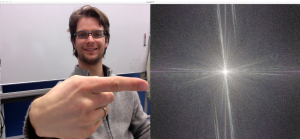
More about this next week, but Ingo has kindly provided a Windows executable version of one of the latest development builds of the Monte Carlo code (with GUI). While I have not yet had the chance to test it (being on a mac myself), please go ahead and get it from here!
Some of you may have seen the Live Fourier Transform video that was made a while ago. I am happy to tell you that there is now a new, better version out of that program (still rather small and straightforward, though).
The idea behind this demonstration program is to show the camera image and the (intensity component of) the Fourier transform alongside. This Fourier transform does to the camera image, what X-rays do to matter: When X-rays interact with matter, they create an interference pattern which is related to the Fourier transform of the electron density structure in the matter.
So with this program, I can show you what X-ray scattering and diffraction looks like for a variety of structures. I have been using the previous version in many of my presentations, where the change of pace and the little show appears to be appreciated by the audience.
The new version uses a much friendlier and faster back-end (OpenCV) for capturing and displaying the images. Furthermore, it uses command-line arguments which can be used to adapt most of the internal parameters to suit your camera and/or needs, and it even works in colour (pointless but fun)!

I tried compiling it so I could pass around a mac os x application instead of requiring the installation of a python environment (Enthought’s the easier one to install) and the OpenCV package (available through the Canopy package manager). Unfortunately, I could not compile it successfully in time for this post due to problems with compiling under the Enthought environment.
The source is available on a Git DVCSS, so community improvements are possible and welcomed!
The new video has just been uploaded. I skimped a bit on the video correction and visuals, but I hope it is enjoyable nonetheless:
